SLVS651B May 2006 – December 2015 TPS62510
PRODUCTION DATA.
- 1 Features
- 2 Applications
- 3 Description
- 4 Revision History
- 5 Pin Configuration and Functions
- 6 Specifications
- 7 Detailed Description
- 8 Application and Implementation
- 9 Power Supply Recommendations
- 10Layout
- 11Device and Documentation Support
- 12Mechanical, Packaging, and Orderable Information
Package Options
Mechanical Data (Package|Pins)
- DRC|10
Thermal pad, mechanical data (Package|Pins)
- DRC|10
Orderable Information
6 Specifications
6.1 Absolute Maximum Ratings
Over operating free-air temperature range (unless otherwise noted) (1)| MIN | MAX | UNIT | ||
|---|---|---|---|---|
| VS | Supply voltage at PVIN, AVIN | –0.3 | 4 | V |
| Voltage at EN, MODE, OVT, FB, PG(2) | –0.3 | 4 | V | |
| Voltage at SW(2) | –0.3 | VIN + 0.3 | V | |
| TJ | Operating junction temperature | –40 | 150 | °C |
| Tstg | Storage temperature | –65 | 150 | °C |
(1) Stresses beyond those listed under Absolute Maximum Ratings may cause permanent damage to the device. These are stress ratings only and functional operation of the device at these or any other conditions beyond those indicated under Recommended Operating Conditions is not implied. Exposure to absolute-maximum-rated conditions for extended periods may affect device reliability.
(2) All voltage values are with respect to network ground terminal.
6.2 ESD Ratings
| VALUE | UNIT | ||||
|---|---|---|---|---|---|
| V(ESD) | Electrostatic discharge | Human body model (HBM), per ANSI/ESDA/JEDEC JS-001, all pins(1) | ±2000 | V | |
| Charged device model (CDM), per JEDEC specification JESD22-C101, all pins(2) | ±1000 | ||||
(1) JEDEC document JEP155 states that 500-V HBM allows safe manufacturing with a standard ESD control process.
(2) JEDEC document JEP157 states that 250-V CDM allows safe manufacturing with a standard ESD control process.
6.3 Recommended Operating Conditions
Over operating free-air temperature range (unless otherwise noted)| MIN | NOM | MAX | UNIT | ||
|---|---|---|---|---|---|
| VIN | Input voltage on pins PVIN and AVIN | 1.8 | 3.8 | V | |
| VOUT | Output voltage | 0.6 | VIN | V | |
| IOUT | Output current, VIN = 1.8 V to 3.6 V | 1500 | mA | ||
| L | Inductor value | 2.2 | μH | ||
| CIN | Input capacitor value(1) | 10 | μF | ||
| COUT | Output capacitance value(1) | 22 | μF | ||
| TA | Operating ambient temperature | -40 | 85 | °C | |
| TJ | Operating junction temperature | –40 | 125 | °C | |
(1) See Application and Implementation for more information.
6.4 Thermal Information
| THERMAL METRIC(1) | TPS62510 | UNIT | |
|---|---|---|---|
| DRC [VSON] | |||
| 10 PINS | |||
| RθJA | Junction-to-ambient thermal resistance | 48.5 | °C/W |
| RθJC(top) | Junction-to-case (top) thermal resistance | 71.2 | °C/W |
| RθJB | Junction-to-board thermal resistance | 23.0 | °C/W |
| ψJT | Junction-to-top characterization parameter | 2.1 | °C/W |
| ψJB | Junction-to-board characterization parameter | 23.1 | °C/W |
| RθJC(bot) | Junction-to-case (bottom) thermal resistance | 4.7 | °C/W |
(1) For more information about traditional and new thermal metrics, see the Semiconductor and IC Package Thermal Metrics application report, SPRA953.
6.5 Electrical Characteristics
VIN = 3.3 V, OVT = EN = VIN, MODE = GND, TA = –40°C to 85°C, typical values are at TA = 25°C (unless otherwise noted)| PARAMETER | TEST CONDITIONS | MIN | TYP | MAX | UNIT | ||
|---|---|---|---|---|---|---|---|
| SUPPLY CURRENT | |||||||
| VIN | Input voltage | 1.8 | 3.8 | V | |||
| I(q) | Power save mode quiescent current AVIN + PVIN |
FB = FB nominal + 5%, MODE = Low | 22 | 30 | μA | ||
| PWM Mode quiescent current into AVIN | MODE = High | 4.4 | 5 | mA | |||
| I(SD) | Shutdown current into PVIN + AVIN | EN = Low, SW = GND | 0.1 | 5 | μA | ||
| UVLO | Undervoltage lockout threshold at AVIN | V(AVIN) falling (1) | 1.55 | 1.58 | V | ||
| Undervoltage lockout hysteresis | 150 | mV | |||||
| T(SD) | Thermal shutdown threshold | Increasing junction temperature | 160 | °C | |||
| Thermal shutdown hysteresis | 20 | °C | |||||
| CONTROL SIGNALS EN, MODE | |||||||
| VIH | High level input voltage | VIN = 1.8 V to 3.8 V | 1.2 | V | |||
| VIL | Low level input voltage | 0.4 | V | ||||
| IIB | Input bias current | 0.01 | 0.1 | μA | |||
| f(sync) | MODE synchronization range | 1.15 | 2.25 | MHz | |||
| Duration of high or low level for synchronization signal(2) | 75 | ns | |||||
| OUTPUT VOLTAGE TRACKING (OVT) | |||||||
| IIB | Input bias current | 0.001 | 0.05 | μA | |||
| VOS | OVT offset voltage | VOS = V(OVT) - V(FB), 0.1 V < V(OVT) < 0.5 V | –15 | 15 | mV | ||
| POWER GOOD (PG) | |||||||
| V(th) | Power good threshold | Feedback voltage rising | –7% VOUT | –5% VOUT | –3% VOUT | V | |
| Power good hysteresis | 2% VOUT | 7% VOUT | V | ||||
| VOL | Low level voltage | I(PG) = 1 mA | 0.3 | V | |||
| Ilkg | Power good leakage current | V(PG) = 3.8 V | 1 | 100 | nA | ||
| OUTPUT | |||||||
| RDS(on) | P-channel MOSFET on-resistance | VIN = V(GS) = 1.8 V | 330 | mΩ | |||
| VIN = V(GS) = 3.3 V | 120 | 170 | |||||
| Ilkg | P-channel leakage current | VIN = 3.6 V | 10 | μA | |||
| RDS(on) | N-channel MOSFET on-resistance | VIN = V(GS) = 1.8 V | 200 | mΩ | |||
| VIN = V(GS) = 3.3 V | 80 | 130 | |||||
| Ilkg | N-channel leakage current | V(DS) = 3.6 V | 10 | μA | |||
| IF | Forward current limit (P- and N-channel) | 1.8 V < VIN < 3.8 V | 1.75 | 2 | 2.25 | A | |
| fs | Oscillator frequency | MODE = High | 1.3 | 1.5 | 1.7 | MHz | |
| Vref | Reference voltage | 0.6 | V | ||||
| VFB | Feedback voltage (3) | PFM operation | VIN = (VOUT + 0.3 V) to 3.8 V | –2% | 5% | ||
| VIN = (VOUT + 0.2 V) to 3.8 V; VOUT= 1.8 V, (4)
C2 = 15 μF, L1= 2.1 μH (effective values), IOUT = 0 mA to 150 mA |
–2% | 2.5% | |||||
| VIN = (VOUT + 0.3 V) to 3.8 V; VOUT= 2.5V, (4)
C2 = 15 μF, L1= 2.1 μH (effective values), IOUT = 0 mA to 150 mA |
–1.3% | 2.3% | |||||
| PWM operation | VIN = VOUT + 0.3 V | –1% | 1% | ||||
| IFB | Feedback bias current | V(FB) = 0.6 V, EN = High | 0.001 | 0.05 | μA | ||
| Line Regulation | VIN = VOUT + 0.3 V (minimum 1.8 V) to 3.8 V; IOUT = 800 mA |
0 | %/V | ||||
| Load Regulation | IOUT = 10 mA to 1500 mA, PWM mode | 0.1 | %/A | ||||
| tSS | Soft start time | VOUT ramping from 5% to 95% of nominal value | 750 | μs | |||
| Leakage resistance from SW pin to GND | VIN > VOUT, 0 V ≤ V(SW) ≤ VIN | 700 | 1000 | kΩ | |||
| Leakage resistance from FB pin to GND | EN = Low | 17 | 23 | ||||
(1) The undervoltage lockout threshold is detected at the AVIN pin. Current through the RC filter causes a UVLO trip at higher VIN
(2) The minimum and maximum duty cycle applied to the MODE pin is calculated as:
D(min) = 75 ns × f(sync) and D(max) = 1 - 75 ns × f(sync).
D(min) = 75 ns × f(sync) and D(max) = 1 - 75 ns × f(sync).
(3) When using the output voltage tracking function, the feedback regulates to the voltage applied to OVT as long as the OVT < 0.6 V.
6.6 Typical Characteristics
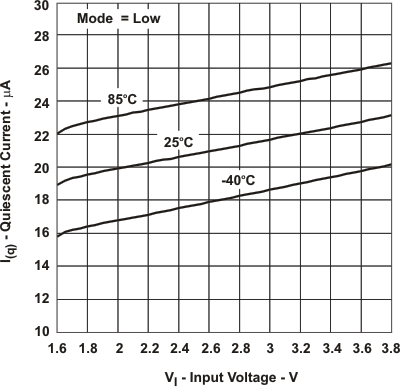 Figure 1. No Load Quiescent Current vs Input Voltage, MODE = Low
Figure 1. No Load Quiescent Current vs Input Voltage, MODE = Low
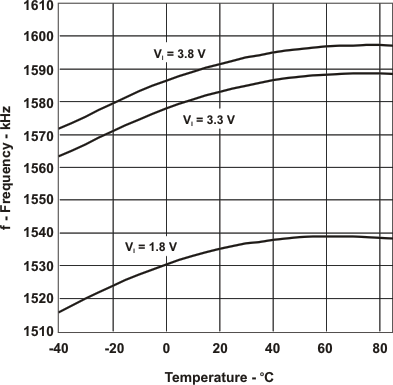 Figure 3. Frequency vs Temperature
Figure 3. Frequency vs Temperature
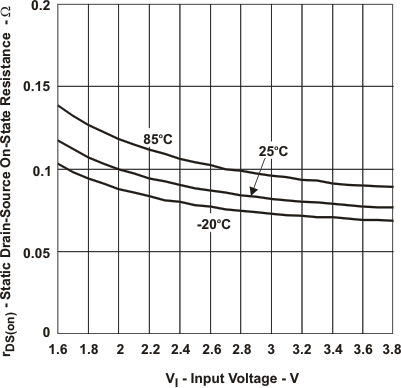 Figure 5. NMOS RDS(on) vs Input Voltage
Figure 5. NMOS RDS(on) vs Input Voltage
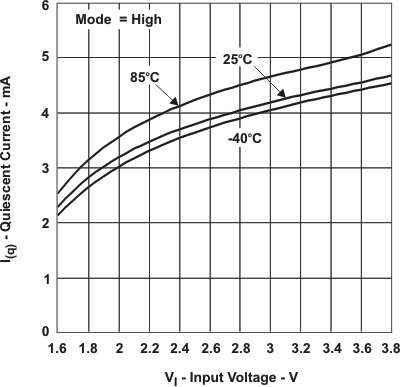 Figure 2. No Load Quiescent Current vs Input Voltage, MODE = High
Figure 2. No Load Quiescent Current vs Input Voltage, MODE = High
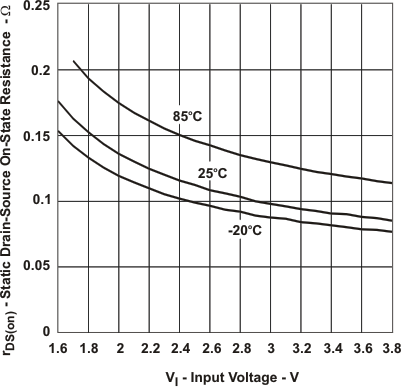 Figure 4. PMOS RDS(on) vs Input Voltage
Figure 4. PMOS RDS(on) vs Input Voltage
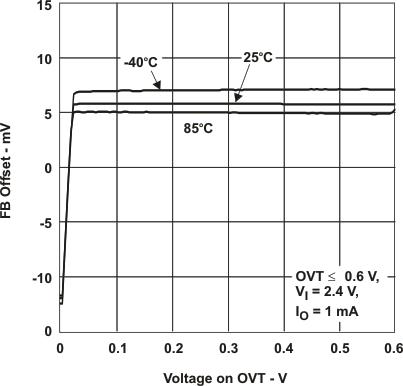 Figure 6. FB Offset vs Voltage ON VOUT
Figure 6. FB Offset vs Voltage ON VOUT